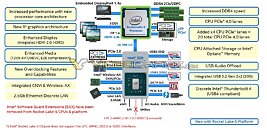Wednesday, July 29th 2020

Intel 11th Gen Core "Rocket Lake-S" ES Shown Running PCIe 4.0 NVMe SSD
Screenshots of a SiSoft SANDRA database submission of an alleged Intel 11th Gen Core "Rocket Lake-S" desktop processor machine confirms that the processor introduces PCI-Express gen 4.0 support to Intel's mainstream desktop platform. PCIe gen 4.0 has been rather limited in Intel's product stack, with only 10th Gen Core "Ice Lake-U" and "Ice Lake-Y" mobile processors supporting it so far. The upcoming 11th Gen "Tiger Lake" mobile processors will support it, too. Intel's HEDT product line, currently led by "Cascade Lake-X," as well as the server side of things, let by "Cooper Lake," are limited to PCIe gen 3.0. The SANDRA screenshot shows the "Rocket Lake-S" powered machine running a PCI-Express 4.0 NVMe SSD.
According to alleged "Rocket Lake-S" + Intel 500-series chipset platform maps leaked to the web by VideoCardz, "Rocket Lake-S" will finally take forward strides in the area of I/O. The CPU socket puts out not just its usual PEG slot (16 lanes meant for PCI-Express graphics cards), but also a CPU-attached M.2 NVMe slot with 4 PCI-Express gen 4.0 lanes, much like Socket AM4 motherboards based on AMD X570 or B550 chipsets. What's more, Intel fattened the chipset bus with 8 lanes. While the bus is still DMI 3.0 (with PCI-Express gen 3.0 physical layer), 8 lanes mean a doubling in bandwidth compared to Intel 400-series chipsets (or older). The 500-series PCH itself will still be PCI-Express gen 3.0 based, putting out only gen 3.0 downstream PCIe lanes, unlike the AMD X570, which puts out gen 4.0 downstream general purpose lanes, and uses a PCI-Express 4.0 x4 pipe to the CPU. Quite a few Intel 400-series chipset motherboards have preparation for PCIe gen 4.0 PEG slot when paired with a "Rocket Lake-S" processor.
Source:
VideoCardz
According to alleged "Rocket Lake-S" + Intel 500-series chipset platform maps leaked to the web by VideoCardz, "Rocket Lake-S" will finally take forward strides in the area of I/O. The CPU socket puts out not just its usual PEG slot (16 lanes meant for PCI-Express graphics cards), but also a CPU-attached M.2 NVMe slot with 4 PCI-Express gen 4.0 lanes, much like Socket AM4 motherboards based on AMD X570 or B550 chipsets. What's more, Intel fattened the chipset bus with 8 lanes. While the bus is still DMI 3.0 (with PCI-Express gen 3.0 physical layer), 8 lanes mean a doubling in bandwidth compared to Intel 400-series chipsets (or older). The 500-series PCH itself will still be PCI-Express gen 3.0 based, putting out only gen 3.0 downstream PCIe lanes, unlike the AMD X570, which puts out gen 4.0 downstream general purpose lanes, and uses a PCI-Express 4.0 x4 pipe to the CPU. Quite a few Intel 400-series chipset motherboards have preparation for PCIe gen 4.0 PEG slot when paired with a "Rocket Lake-S" processor.


35 Comments on Intel 11th Gen Core "Rocket Lake-S" ES Shown Running PCIe 4.0 NVMe SSD
When will Intel learn?
Wonder who that was ?
I feel like I could've said that in so many news articles lately, lol.
Also uh, this has to do with chipset limitations, I have not yet seen a consumer chipset that can handle x16 configurations. While Z490 CAN do 24 lanes, look carefully at the Z490 product page on Intel ARK. In fact, please feel free to check every single chipset there is, I guarantee you there are no consumer chipsets that could do x16. They can do x1, x2, and x4. So yes, it IS viable to use chipset lanes for pcie lanes, it is not viable to use them for anything that requires x8 or x16.
PLX chips cost a lot of money is one reason. Another is that most users don't need such a thing on mainstream platforms in the first place. That is (part of the reason) why HEDT exists as it is a crossover for more PCIe lanes, more bandwidth, etc. That said, I know the Supermicro Z490 boards use a PLX chip. So if you need all those lanes and still are in the mainstream platform... there are at least two boards out there that will do it. But think about it... if this really was a want or need, we'd see a lot more out there. As it is, PLX chips have become more rare as each passing generation goes by (in part due to more lanes on the CPU).